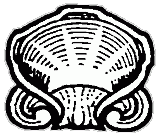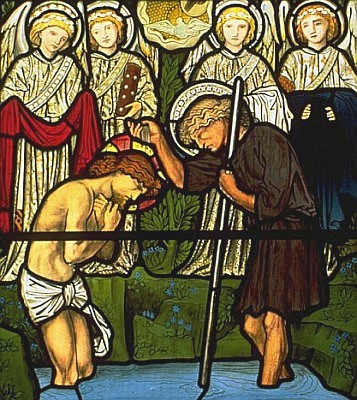|
With this Feast, Christmas ends liturgically, though it continues on in spirit and as a liturgical cycle until Candlemas when we recall Mary’s post-birth Purification and Our Lord’s Presentation in the Temple.
On this, the Octave of the Epiphany, we continue to focus on the Mysteries that entered our hearts on Twelfthnight and the Epiphany, but today more specifically with regard to the Baptism of Jesus by St. John the Baptist in the River Jordan. He Whose birth we just celebrated now shows us how to be born again or “born from above.”
The marvelling at the Theophany continues in pondering the meaning of His Baptism, a meaning made more apparent by the Gradual, Alleluia, Offertory, Preface, and Communion prayers of today’s Mass, all of which allude to the Magi and their recognition of Jesus as King and God. The Gospel reading comes from the first chapter of John, verses 29-34:
The next day, John saw Jesus coming to him, and he saith: Behold the Lamb of God, behold Him Who taketh away the sin of the world. This is  He, of whom I said: After me there cometh a man, who is preferred before me: because He was before me. And I knew Him not, but that He may be made manifest in Israel, therefore am I come baptizing with water. He, of whom I said: After me there cometh a man, who is preferred before me: because He was before me. And I knew Him not, but that He may be made manifest in Israel, therefore am I come baptizing with water.
And John gave testimony, saying: I saw the Spirit coming down, as a dove from heaven, and He remained upon him. And I knew Him not; but He Who sent me to baptize with water, said to me: He upon Whom thou shalt see the Spirit descending, and remaining upon Him, He it is that baptizeth with the Holy Ghost. And I saw, and I gave testimony, that this is the Son of God.
St. John the Baptist, the prophet whom prophets foretold, heralded the Christ during Advent, and now, at the end of the liturgical Christmas season, gives testimony once again. He gives this witness not only by being in the spirit of Elias (IV Kings 1:3-8), but by the place he chose as the site of his baptisms: the River Jordan, where Elias (Elijah) was last seen before he was taken up to Heaven, and the waters of which were healed by Elias’s son, Eliseus (Elisha): IV Kings 2:11-19-22 And as they [Elias and Eliseus] went on, walking and talking together, behold a fiery chariot, and fiery horses parted them both asunder: and Elias went up by a whirlwind into heaven. And Eliseus saw him, and cried: My father, my father, the chariot of Israel, and the driver thereof. And he saw him no more: and he took hold of his own garments, and rent them in two pieces. And he took up the mantle of Elias, that fell from him: and going back, he stood upon the bank of the Jordan, And he struck the waters with the mantle of Elias, that had fallen from him, and they were not divided. And he said: Where is now the God of Elias? And he struck the waters, and they were divided, hither and thither, and Eliseus passed over…
…And the men of the city said to Eliseus: Behold the situation of this city is very good, as thou, my lord, seest: but the waters are very bad, and the ground barren. And he said: Bring me a new vessel, and put salt into it. And when they had brought it, He went out to the spring of the waters, and cast the salt into it, and said: Thus saith the Lord: I have healed these waters, and there shall be no more in them death or barrenness. And the waters were healed unto this day, according to the word of Eliseus, which he spoke.
But more importantly than this witness, the Father Himself and the Holy Ghost give testimony. St. Matthew’s account of this Divine testimony is more explicit. From the third chapter of his Gospel:
And Jesus being baptized, forthwith came out of the water: and lo, the heavens were opened to him: and he saw the Spirit of God descending as a dove, and coming upon him. And behold a voice from heaven, saying: This is my beloved Son, in whom I am well pleased.
This revelation of His glory was predicted in Isaias 40:3-5: 3
The voice of one crying in the desert: Prepare ye the way of the Lord, make straight in the wilderness the paths of our God. Every valley shall be exalted, and every mountain and hill shall be made low, and the crooked shall become straight, and the rough ways plain. And the glory of the Lord shall be revealed, and all flesh together shall see, that the mouth of the Lord hath spoken.
This Feast is like that of the Pentecost in its revelation of the Trinity, and even more is it like the Feast of the Transfiguration which commemorates the events that took place on Mt. Tabor, when Christ’s Divinity was evident in His glorious Light, when the bright cloud overshadowed Him, and when the words of the Father echoed what was heard at the River Jordan:
Matthew 17:1-5
And after six days Jesus taketh unto him Peter and James, and John his brother, and bringeth them up into a high mountain apart: And He was transfigured before them. And His Face did shine as the sun: and His garments became white as snow. And behold there appeared to them Moses and Elias talking with Him. And Peter answering, said to Jesus: Lord, it is good for us to be here: if thou wilt, let us make here three tabernacles, one for Thee, and one for Moses, and one for Elias. And as he was yet speaking, behold a bright cloud overshadowed them. And lo, a voice out of the cloud, saying: This is My beloved Son, in whom I am well pleased: hear ye Him.
This Divine manifestation helps explain why Jesus — the Sinless One, the Pure and Unspotted Lamb — would be baptized at all: so that He would be known for Who He is, so that He would be made manifest.
In addition to this reason, St. Thomas Aquinas (d. 1274), in his Summa Theologica, gives us three other reasons for the fittingness of St. John baptizing Christ. One is so that Christ might sanctify Baptism, a sentiment expressed by St. John Chrysostom (d. 407) when he wrote “In truth, Christ needed not baptism, neither his nor any other; but rather baptism needed the power of Christ.” Another is so that John, by baptizing, “might accustom men to the Baptism of Christ.” And the last is so that “by persuading men to do penance, he might prepare men to receive worthily the baptism of Christ.” Here he quotes the Venerable Bede:
…the baptism of John was as profitable before the baptism of Christ, as instruction in the faith profits the catechumens not yet baptized. For just as he preached penance, and foretold the baptism of Christ, and drew men to the knowledge of the Truth that hath appeared to the world, so do the ministers of the Church, after instructing men, chide them for their sins, and lastly promise them forgiveness in the baptism of Christ.
|


 He, of whom I said: After me there cometh a man, who is preferred before me: because He was before me. And I knew Him not, but that He may be made manifest in Israel, therefore am I come baptizing with water.
He, of whom I said: After me there cometh a man, who is preferred before me: because He was before me. And I knew Him not, but that He may be made manifest in Israel, therefore am I come baptizing with water.